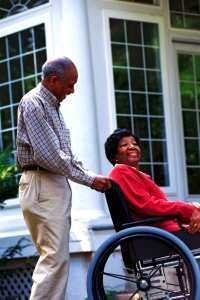
The fastest growing segment of our population is the 70 and over age group and a growing percentage of people in this age range want to remain in the comfort and security of their own homes for as long as possible. One of the greatest obstacles to seniors being able to live independently is the prevalence of injuries incurred from falls in the home.
Helping seniors reduce their risk of falling is the single most important thing that can be done to increase independent living and, considering the much higher life expectancy for seniors living at home, perhaps the single most important thing that can be done for seniors' quality of life.
Consider the following startling statistics:
1. Falls are responsible for 40% of admissions to nursing homes.
2 .70% of accidental deaths in people over 75 years of age are caused by falls.
3. One in three older adults living at home falls each year (this considers only those falls that result in reported medical care).
4. Injuries from falls result in medical costs of $70 billion each year. The human costs are even greater as individuals, caregivers, and families are all impacted by a fall.
Clearly, it is important to ensure that the senior's home — and the homes of family members where they visit — be made as fall-proof as possible. This is a difficult task, considering that there are many factors involved in causing falls, both internal and external.
Internal factors such as slowed reflexes, balance disorders, weakness, muscle tightness, reduced flexibility, cognitive impairments, low blood pressure and visual deficits all contribute to the risk of falling. Controllable external factors including effects of medications, poor lighting, cluttered living spaces, lack of handrails, unstable chairs and rugs that aren't secured are just some of the factors that can lead to a devastating fall. It's important that fall-proofing steps account for all these factors.
Pitfalls in Each Area
There are many steps for preventing falls that don't involve the interior of the home, such as taking stock of medications, having vision and hearing checked, keeping glasses clean, and wearing sturdy, well-fitting shoes.
However, if the home itself is unsafe, all such preventative measures can become irrelevant. Each area of the house has its own potential pitfalls and remedies.
For example, with the stairway area, it's important to ensure that the step surfaces are non-slip, that the edges are visually marked in some way to avoid tripping, that the edges are visible in low light conditions, and that the steps are even and in good repair. Make sure that handrails are present and that they are at a height suitable for the senior.
The type of furnishings used can also have an important impact on fall-proofing. Seniors should ensure that they use uncut, low pile carpeting instead of thick pile when possible, and that they replace old windows with polarized glass or have tinting applied to eliminate glare without reducing light. They should also use chairs that have seating at least 14-16 inches from the floor and sturdy armrests to provide leverage during sitting or rising.
In the kitchen, there is a range of hazards that should be kept in mind. Dishes and food should be stored on lower shelves for easy access. Lighting should be sufficient. Use of step stools should be avoided whenever possible but when necessary a step stool that has a high handle and non-slip treads should be used. Lightweight pots and pans should be used whenever possible.
Most Fall In The Bedroom
The room where perhaps the most falls occur is the bedroom. It's important for seniors to stand slowly when getting out of bed to give the body time to adjust to an upright position. Seniors should wear well-fitting slippers and avoid nightwear that drags on the ground.
The bed itself should be at least 18 inches high from the top of the mattress to the floor. The edge of the mattress should be firm enough to support a seated person without sagging.
In the master bathroom, there should be a non-slip surface, and grab bars should be securely fastened next to the toilet. In the tub and shower areas, there should be non-skid strips, decals or rubber mats in the tub and shower, and the tub and shower should have a seat.
Resources Available
While following this fall-proofing checklist cannot guarantee that no falls will occur in one's home, it can make every senior much safer. Moreover, there are many resources available to give customized assistance on applying these steps to one's home.
The Senior's Choice, a network of senior companion caregivers, offers free seminars throughout North America to educate seniors and their family members on how to implement fall-proofing measures. They can be reached at (800) 481-2899.
Many local senior centers also provide assistance in this regard, either free or for a small charge. If seniors and their family members can successfully implement a comprehensive fall-proofing strategy, countless injuries can be prevented, more seniors can live independently for longer and the quality and duration of life can be extended significantly.



Leave a Comment